 wine events
wine events Talk Of The Town
 Wednesday, May 26, 2010 at 7:07PM
Wednesday, May 26, 2010 at 7:07PM This past Saturday Ghirardelli Square in the city was flooded with hundreds of wine enthusiasts, some just enjoying good tunes and company but some were questing for an undiscovered treasure. Of course Ryan and I were there pouring wine and spreading the word for Deerfield. I’ve represented Deerfield at about a half-dozen wine events and competitions now and we always get a good reception. People love our wine and always let us know, but this event was different. There was some electricity in the air and the crowd was buzzing. Those who know Deerfield always make it a point to seek us out at events but we are always working to introduce more wine drinkers to the quality of our wine. Normally we work very hard to attract people but this time something special happened. It was like a chain reaction: a few people stopped by, tasted, savored and next thing you know came back with a group of friends. People saw the commotion at our table and checked out what was going on. Next thing you know we had attracted a would like to think they were there to talk to us but know that the wines speak for themselves so and we all know they have an eloquent tale to tell. People really appreciated the difference in what we are doing. Our blends made us stand out. Our Merlot Cuvée is the soft approachable wine that everybody can enjoy. Our Old Vine Zin is the intense style that zin lovers gravitate towards. What really made this event different was getting to show Deerfield to so many people who appreciated fine wine. There were people there from all walks of life and people at very different stages of developing their palate for wine and everyone seemed to really care what they were drinking and realized what a good value they had found. One young gentleman who many would expect to see with a pint glass as opposed to a wine glass took out his homemade list he had typed up on Excel with all of the wineries present at the event and a grading rubric and pointed to it and said our 2005 Cabernet Sauvignon, Sonoma County got an 8 which he explained was “reeeeeally good.” I for one am excited. I feel like this is a renaissance where enjoying quality wine is no longer viewed by as a bourgeoisie indulgence. It’s somewhat surprising that this increased interest in quality wine is taking place during an economic downturn but I think what people are really looking at is the value of wine, dependent on the price. People will buy wine at a price point they can afford – what’s important is that they care what it is they’re drinking and are cognizant about what’s out there. They are actively seeking a great value. I’m part of this new generation of wine drinkers so I’m very pleased with the current trend. Just pick up a copy of Wine Enthusiast’s may issue and count many times they talk about Millennials, the wine drinkers from age 21 to 35. Here in Sonoma there’s an upcoming wine competition where all of the judges will be members of the Millenial generation. It will be very interesting to see the results. Until next time, Salut!
 wine events
wine events Vying With Vines
 Wednesday, June 2, 2010 at 1:37PM
Wednesday, June 2, 2010 at 1:37PM Sonoma Valley’s hillsides are covered in rows of lush green leaves. At Deerfield the Organic Syrah vines are in full swing, blooming into great bushy hedges soaking up the sun and clamoring for attention. It’s remarkable how fast they’re growing. It seems like inches a day and I could swear that if you watch them closely you can see them grow. During this period of incredible vigor two things are happening right now in the vineyard: As I discussed in this week’s episode of Cellar Rat TV, our vines are going through inflorescence (or flowering). I had mentioned at the end of April that it looked like they were going to flower soon – but it turned out that they are right on time and the flowers are just beginning to form. That seems fortunate because this unusually wet May threatens the formation of grapes by unleashing a downpour on the fragile flowers, potentially destroying them or washing away the pollen. If that happens the result could be grape bunches with too few grapes on them or none at all. Luckily most of the flowers are still encased in the calyptra, the shell of fused petals, which hopefully will shield them from the rain. The weather is beginning to warm now and although some showers are promised later this week, I think the worst is behind us. Soon the flowers will have pollenated themselves and the vines will enter a short period called fruit set where the flowers transform into little immature grapes.
As the vines work to produce their fruit, the tendrils that support the leaves and clusters of grapes are beginning to snake outwards and are now long enough to tie to the trelise. If you thought pruning the vast vineyards in the winter was a challenge it seems easy compared to the tedious process of coaxing each vine into the desired shape. It requires a gentle touch because, unlike the wooded part of the vine, the green new growth is fragile and must be handled with care. At the same time some of the canopy might be reduced if the leaves seem too thick to allow the wind to flow through and keep the vines dry. I’ll talk more about the benefits of trellising at a later time but sufficed to say there is a multitude of reasons for having some sort of system which can look radically different because the shape of the vine itself is so malleable. The one we employ is the traditional double cordon method, which is by far the most commonly used system in California. The vine is split into two main arms called cordons which run in opposite directions horizontally along the bottom of the trellis. The new growth is trained straight upwards allowing the leaves to form a sheet that is evenly exposed to sunlight. The grapes hang down along bottom of each cordon allowing them to receive sunlight, air flow, and increase the ease of harvest. Just a small portion of the vineyard is done so far but slowly the growers are affectionately creating order out of chaos. The grape growers of Sonoma Valley still take a close, hands-on appoach, paying special attention to each vine which reflects their mindfulness of the principles of organic, sustainable, and biodynamic farming.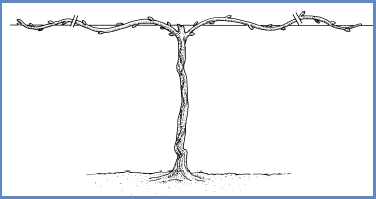
 vines,
vines,  viticulture
viticulture Sculpting The Vineyard
 Wednesday, June 9, 2010 at 5:27PM
Wednesday, June 9, 2010 at 5:27PM When people stop by the tasting room they often ask me if the acres of sculpted vineyards are difficult to manage. The truth is that trellising the vines is a lengthy but crucial process. The use of a trellising method is arguably the most important tool in the grower's arsenal. The key to producing potent, flavorful berries is channeling the vine's energy into producing the fruit. Vitis vinefera is a vigorous plant and each year, if left to its own devices, will erupt into a jumbled leafy mass. But wine isn't made out of leaves. It's made out of delicious grapes. So there has to be a way to make sure that the precious energy the vine expends isn't wasted on growing more leaves than is necessary to adequately perform the photosynthesis required to nourish the plant. That's where trellising comes in. Among other things, the trellis allows the grower to restrict vegetative growth and also the fruit yield of each vine. As I mentioned last week, the trellising system also benefits the vine by creating a canopy that is evenly exposed to sunlight and is less dense. This promotes air circulation which is good for the respiration of the leaves and is also the first line of defense against mold and mildew. Over the years, humans have devised many clever and diverse ways to manipulate the shape of the vine. Although the cordon system is the most widely used in California, there are many different approaches used locally. All of these pictures were taken within a quarter mile of the Deerfield Ranch Winery.

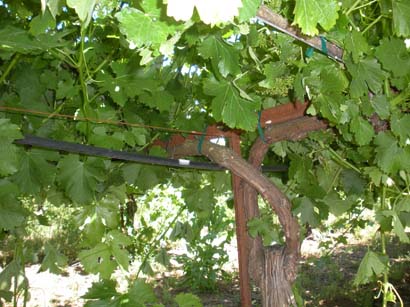
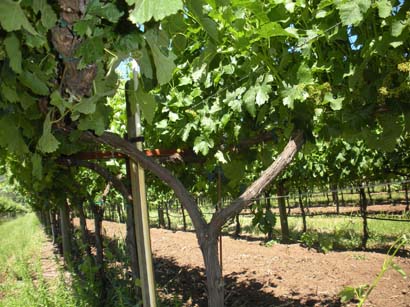
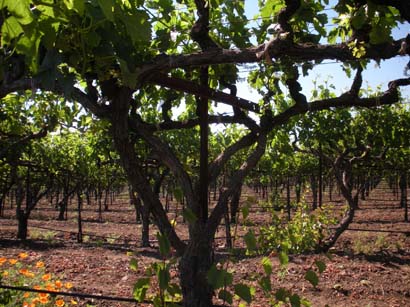
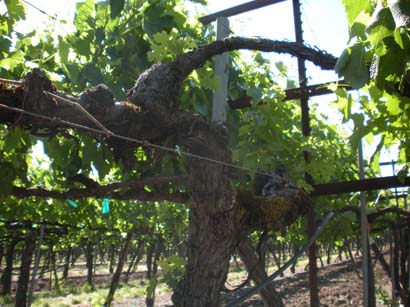
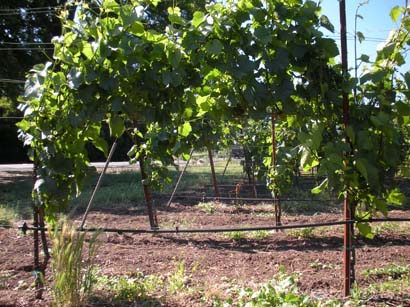
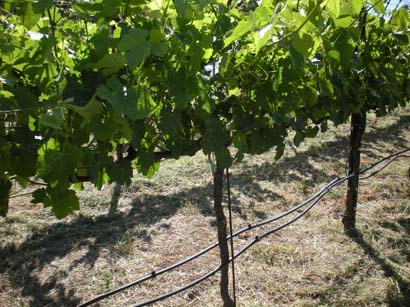
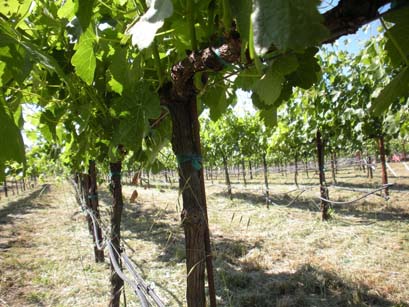
Types of trellis systems:
The Guyot system, named for the French scientist who invented it, has become extremely popular since it was created in the 19th century. The vine is split into two arms called cordons which run horizontally in opposite directions along a wire with the shoots trained upwards.
The Vertical Shoot Positioned trellis (or VSP) is very similar to the Guyot design except that there are four arms along two different guide wires instead of two arms.
The cordon training system which also bears close resemblance to the Guyot system is the preferred method in America. All of Deerfield's organic syrah vines are trained in this fashion. One of the great benefits of this system is that it makes pruning relatively simple so that vineyard workers can perform the task perfectly with little training.
A relatively new addition to viticulture is the Scott Henry trellis, conceived of by a winemaker from Oregon. It is a variation of the VSP system where the shoots of the lower cordons are trained downward, creating two separate canopies.
The Gobblet is the oldest technique and is in declining use but it is still a core method in use throughout the Old World (especially Spain and Greece). Because there is no support system the vine takes on a bushy shape. The trunk, called the head, is pruned close to the ground and several main arms support the fruit. There are several disadvantages to this system however. It is extremely difficult to harvest the low-lying grapes. Several years ago I helped harvest a vineyard in Greece that made use of this system and my back ached for weeks after toiling hunched over all day. It also doesn't allow very good airflow and is very difficult to prune correctly.
There are many more types of trellising systems, some more exotic and creative than others. But as with most things, simplicity is often an essential element of good design. Next time you're at Deerfield take a moment to try and figure out which kind of trellis has been employed!
 trellising,
trellising,  vines,
vines,  viticulture
viticulture The Philosophy
 Wednesday, June 16, 2010 at 9:58PM
Wednesday, June 16, 2010 at 9:58PM Whenever I am pouring Deerfield wine for people who have never had it before I always try share with them the idea behind our winemaking technique. It occurred to me that the readers of this blog have been oddly neglected especially considering that by now you have a great deal of insight into the process of making the wine. In fact, there are so many different approaches to winemaking that understanding the guiding philosophy is critical to making it. You can learn the “how”, but when you also grasp the “why”, well, that’s when the picture comes into view. Why do we clean equipment three times before we use it? Why do we wait so long before we release our wines? Why are Deerfield wines so darn tasty?
One of the core tenets of our winemaking philosophy is an overriding dedication to cleanliness. As I wrote in some of my earlier blog entries cleaning every square inch of the winery and its equipment is integral to the life of a cellar rat. Often to do a job that takes ten minutes 30 minutes of cleaning is required before and after. But all the attention to detail is well worth it because, as Robert says, “wine reflects its environment”.
Another key element in our strategy is careful selection of the fruit that we make wine from. We utilize a three tiered system to sort the grapes: An initial sort is performed in the vineyard as the bunches are harvested. Once transported to the crush pad and weighed, the grapes are again sorted by cluster and we remove any bunches that aren’t perfect. Mold, mildew, raisins, under-ripe – anything that doesn’t belong gets tossed. Then after the grapes go through the destemmer, they are sorted once more by the individual berry. This is a process that is only practical for a boutique winery due to the fact that it is a meticulous and time consuming endeavor. It is of the essence, however, because removing everything but just the grapes keep the resulting wine low in histamines. When the yeast encounters a foreign body that it does not recognize it produces histamines to protect itself similarly to the human body. It has been shown that histamines can provoke allergic reactions which may cause the headache that some people associate with red wine. Because of the careful attention we put into production people who typically suffer from migraines can enjoy world-class red wine that they otherwise would never be able to.
Another thing I always point out is that Deerfield’s flagship wine is a blends. Sure, we have some truly excellent single varietal wines (like our Old Vine Zin which recently got 95pts from the wine enthusiast) but the majority is made from more than one varietal or one vineyard, or both! Red Rex alone has seven different varietals. Why? Because, as Robert has told me, winemaking shares many of the principles of cooking. The evidence of that is clear: Skilled winemakers are also talented chefs. Why does that matter? I believe you would be hard-pressed to find a recipe that uses only a single ingredient. By adding different varietals you are enriching the tasting experience. Each one brings something new to the palate, each a unique personality to explore. There’s always so much talk about terrior in conversations about wine. How the confluence of environmental factors in the vineyard create a unique flavor. By including grapes from different and sometimes distant locations, you can allow the distinct terriors to mingle and the result can be wonderfully complex wines. The key is balancing all these flavors on the taste buds. It’s no easy feat and perhaps that’s why some winemakers shy away from blending. There’s far more to say on the topic of blending and Robert has invited me to sit in on some technical blending trials so I will have more on the subject soon.
 clean wine,
clean wine,  winemaking
winemaking Getting Dirty
 Wednesday, June 23, 2010 at 7:02PM
Wednesday, June 23, 2010 at 7:02PM As I was walking through the vineyards, fixing the irrigation and trellising the new growth, I noticed the rich, black earth that the vines were growing in. Soil composition dramatically impacts the finished wine and is a key reason that only certain regions are suited to growing wine grapes, which have very different needs than many crops. Most farmers would be envious of a land owner whose soil is nutrient-rich and fertile. Yet farmers that cultivate the land for the production of wine grapes know that quality wines are produced by the vine's struggle to create the seeds it needs to reproduce. If the vines are too well accommodated they will instead produce grapes that are large and have less flavor, appropriate for the table but not for the bottle. It is crucial for the soil to retain water adequately but also be extremely well drained. It is helpful if the topsoil can retain and reflect heat, aiding the ripening process. Most grapevines do well with a pH between 5 to 6 but some varietals do well in more balanced soils from about 6 to 8. Calcium, iron and magnesium are minerals that are essential to the life of the vine, as well as nitrogen, phosphorus and potassium which are requisite to most plant life. However, grapevines are a remarkably tolerant and robust plant and can flourish in many different types of soils. Deerfield's vineyards, like much of Sonoma County, are composed of recent volcanic soil. The trace elements that the plant absorbs through its roots can dramatically impact the flavor of the grapes, although the idea that a wine contains the flavors of the minerals is somewhat of a myth. The famed wines produced from the slate soils of Germany's Mosel Valley are often described as possessing mineral flavors, but while soils can be accurately attributed to creating flavors ubiquitous to a specific terrior it is somewhat more difficult to pin down what exactly slate smells like. The field of soil science is one of the most extensively studied aspects of viticulture at oenological institutions around the world. But there is far more to a perfect bunch of Pinot Noir grapes than just the soil that the vines roots live in. Next time I'll describe the elements that make up terroir.
 vines,
vines,  viticulture
viticulture 
